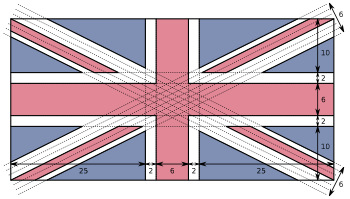Flags are designed to simply be a representation of whatever you are wanting to display, be proud of, support or advertise. Some flags by design are very simple, some are rather complex and then there is the Union Jack. Its widely believed that due to the nature of the United Kingdom’s flag and countries that it represents that it’s one of the most complex flag designs ever created.
The flag itself has been in place since around 1801. Its design however took a while to create and still remains very specific and it has a number of rules that many people might not be aware of. These rules have to be followed exactly and any changes actually have to go through Parliament. In 2008 an MP by the name of Andrew Rosindell tried to get the aspect ratio of the flag changed but this did not get past the first reading in Parliament before it was quashed.
Specification
Flags that have the Union Jack in the canton should always be 1:2 to preserve the square fly area
The three component crosses that make up the Union Flag are sized as follows:
- The red St George’s Cross width is 1⁄5 of the flag’s height with a 1⁄15 flag height fimbriation.
- The white diagonal St Andrew’s Cross width is 6⁄30 of the flag’s height, visible on either side of the St Patrick’s Cross in diagonals of 1⁄10 and 1⁄30 of the flag’s height, respectively.
- The red diagonal St Patrick’s Cross width is 1⁄15 of the flag’s height. It is offset by 1⁄30 of the flag’s height in anti-clockwise direction. According to the official blazon of 1801, the white diagonal St Andrew’s Cross is in fact counterchanged with the red diagonal of St Patrick’s Cross. In this interpretation, the width of both saltires is 1⁄15 of the flag’s height, with fimbriations of 1⁄30 of the flag’s height on either side of the red saltire.
The crosses and fimbriations retain their thickness relative to the flag’s height whether they are shown with a ratio of 3:5 or 1:2
The Admiralty in 1864 settled all official flags at proportions 1:2, but the relative widths of the crosses remained unspecified, with the above conventions becoming standardised in the 20th century.In the 19th century, the Union flag was defined by the same blazon but could vary in its geometrical proportions.
Colours
The colour specifications for the colours Union Jack (royal) blue, Union Flag red and white are
| Scheme | Blue[30] | Red[31] | White |
|---|---|---|---|
| Pantone (paper) | 280 C | 186 C | Safe |
| HEX | #012169 | #C8102E | #FFFFFF |
| MoD | 8711D | 8711 | 8711J |
| NSN | 8305.99.130.4580 | 8305.99.130.4584 | 8305.99.130.4585 |
| CMYK | 100.85.5.22 | 2.100.85.6 | 0.0.0.0 |
| RGB | 1, 33, 105 | 200, 16, 46 | 255, 255, 255 |
All HEX, CMYK and RGB specifications for the Pantone colours are taken from the official Pantone website on the webpages of the corresponding colours. Keep in mind that although the colour schemes are official, not all of the colours are completely congruent. This is due to different specifications for different types of media (for example, screen and print).
Exerts taken from Wikipedia https://en.wikipedia.org/wiki/Union_Jack
Our Union Jacks can be purchased direct from our website https://piggotts.co.uk/products/flags/union-jack-national-flag/



